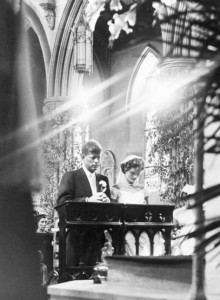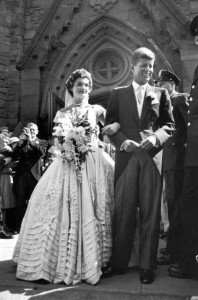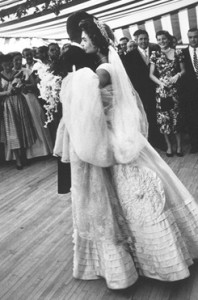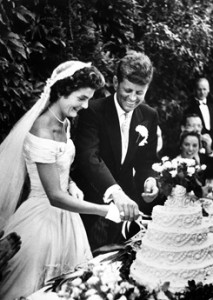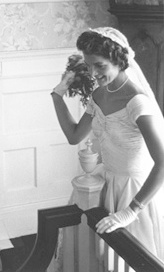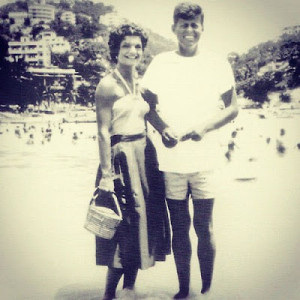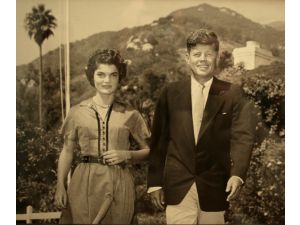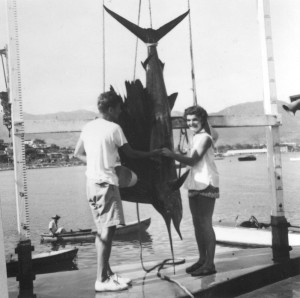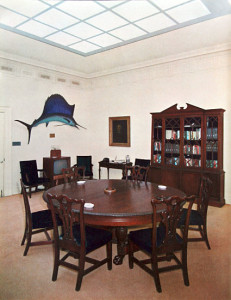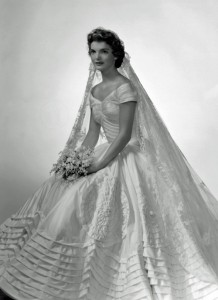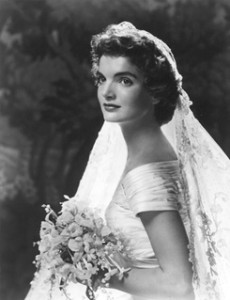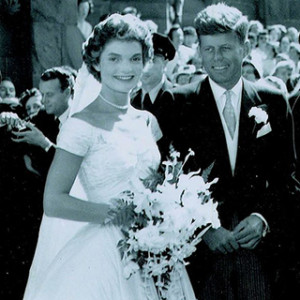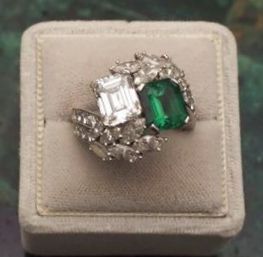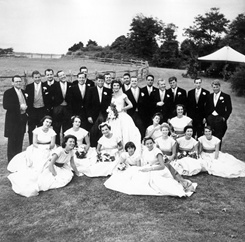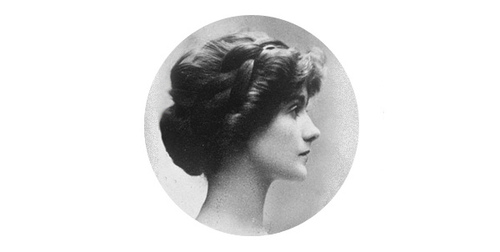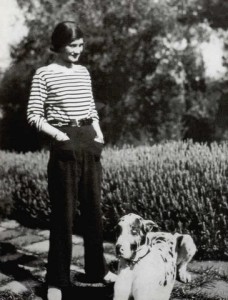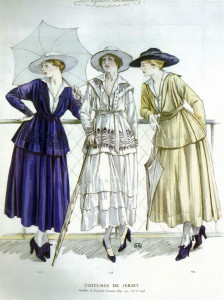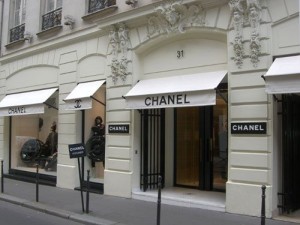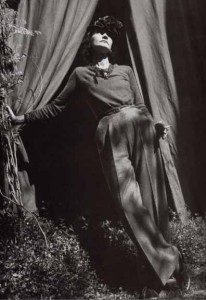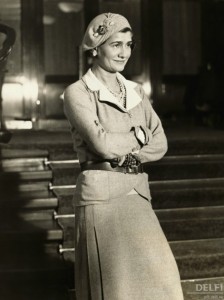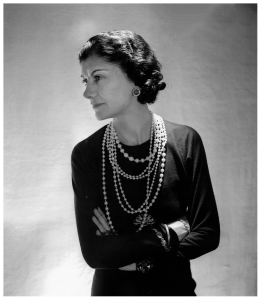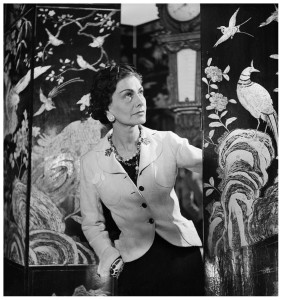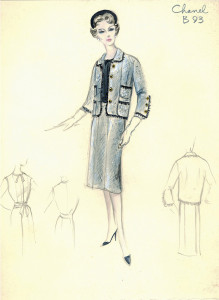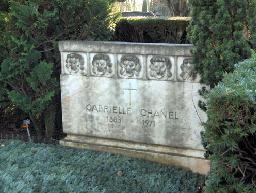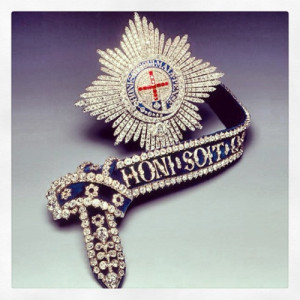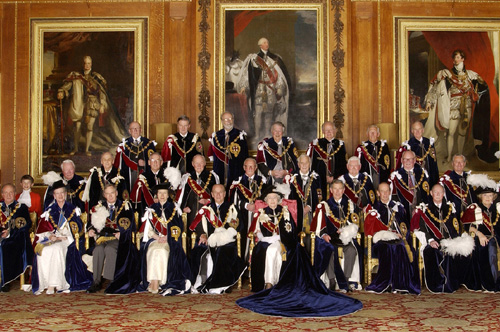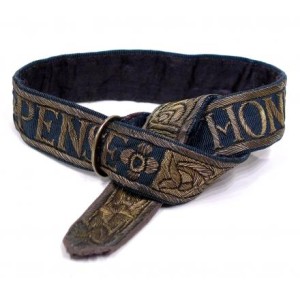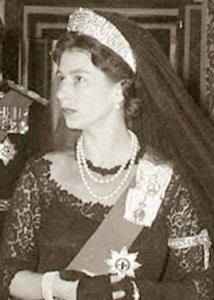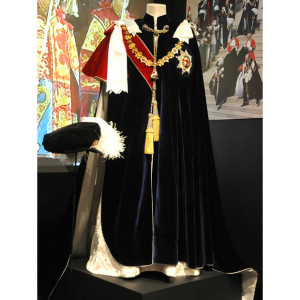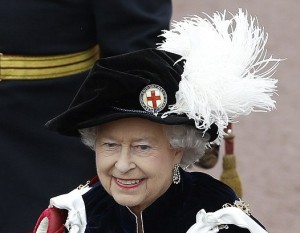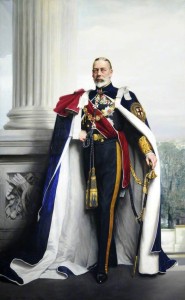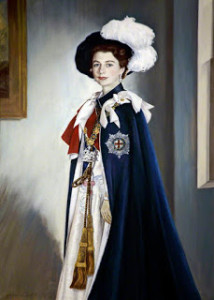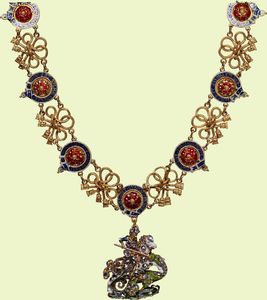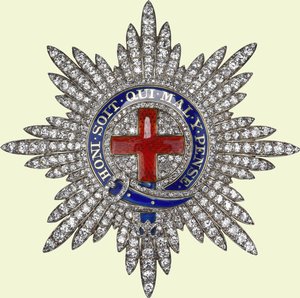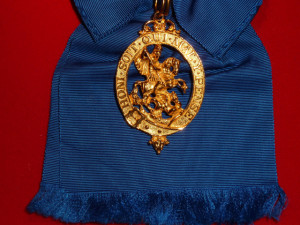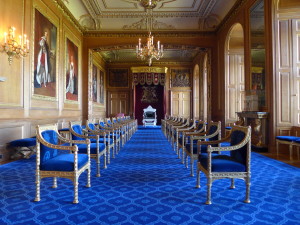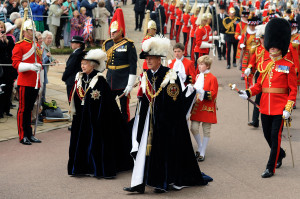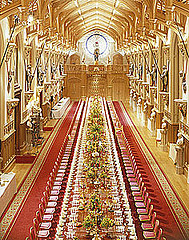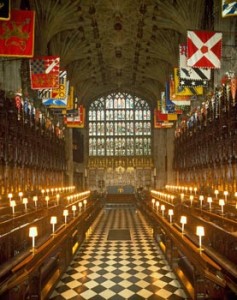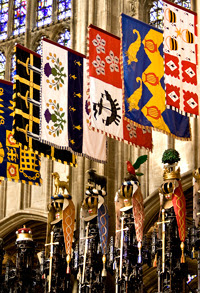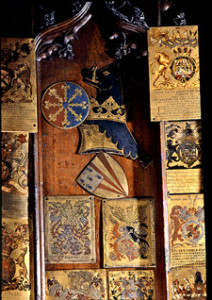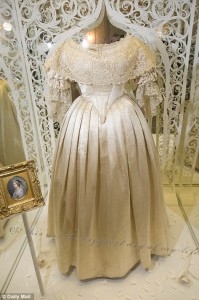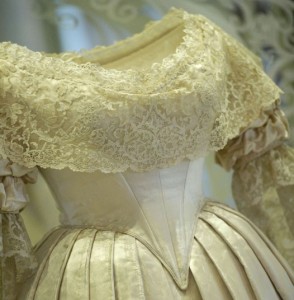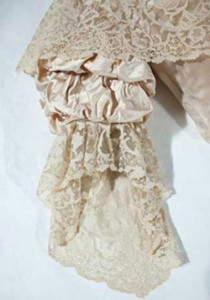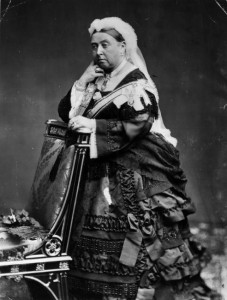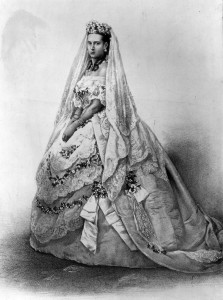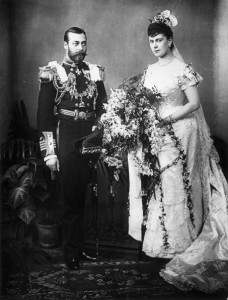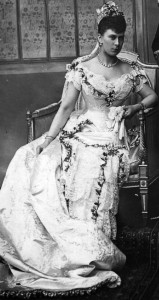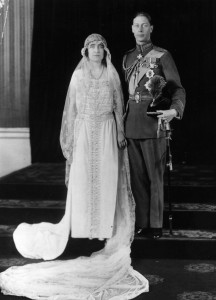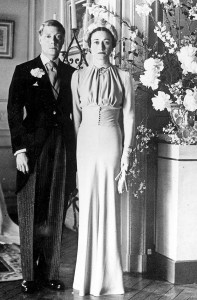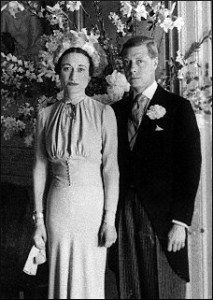In the first of the two part series on Royal Wedding Dresses, I discussed five wedding dresses of the Royal brides from the previous centuries starting with Queen Victoria who had married Prince Albert in 1840 through to the Duchess of Windsor who married the Duke of Windsor in 1937. In the second part in the series, I will discuss six more recent wedding dresses starting with Princess Elizabeth who married Prince Philip in 1947 (they will be celebrating their 68th wedding anniversary this November) through to the Duchess of Cambridge, the former Kate Middleton, who married Prince William in April 2011.
Princess Elizabeth’s wedding dress
Princess Elizabeth (the future Queen Elizabeth II) married Philip Mountbatten (now known as the Duke of Edinburgh) on November 20, 1947 at Westminster Abbey in London. At the time of the wedding, World War II had recently ended but due to food and supply shortages coupon rationing was still in effect. After the engagement was announced, thousands of clothing coupons were received at Buckingham Palace to assist in making a wedding dress fit for a Royal Princess but it was illegal to transfer coupons. For this reason, the coupons were rightfully returned with a letter from Princess Elizabeth thanking the people for their generosity and thoughtfulness.
Norman Hartnell had been the long standing and favorite designer of Queen Elizabeth, Princess Elizabeth’s mother, since 1938 and he received the commission to create the wedding dress. It has been said that Hartnell was inspired by the paintings of Botticelli that he had seen and at the time he thought the wedding dress for Princess Elizabeth was the most beautiful dress he had ever created. He designed a lovely gown of ivory duchess satin with a fitted bodice and full skirt that extended into a 15 foot train. The dress and train were elaborately embroidered with garlands of satin appliqued starflowers, roses and wheat created with silk thread, 10,000 seed pearls and crystals. (Hartnell was also commissioned to create another important dress for Princess Elizabeth who was destined to become Queen of England. For more information on her coronation dress, please click on the link to the Coronation of Queen Elizabeth II)
Special Note: Due to the recent war and the ongoing hostilities with Japan, silkworms from China were used to manufacture the silk for Princess Elizabeth’s wedding dress. After the wedding, the dress was donated to the London Museum but sadly throughout the following years the choice of the silk material has proven to be a poor one and the fabric has severely deteriorated caused by the weight of the heavy embroidery and beading.
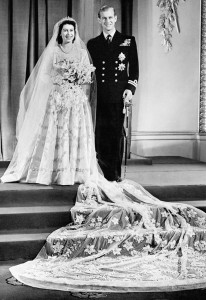
To complete the bridal ensemble for her wedding day, Princess Elizabeth wore a white silk tulle veil held in place by the diamond King George III Fringe Tiara. Unfortunately, while preparing for her wedding day the frame of the tiara broke in half but luckily the royal jeweler was called in to quickly make the repair before the ceremony. Royal Note: Princess Elizabeth was the first royal bride that wore her bridal veil covering her face.
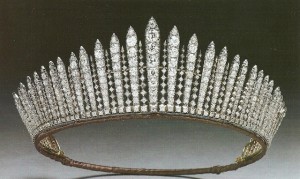
Princess Elizabeth’s bridal bouquet was made by the local British florist Longmans from three different kinds of British-grown orchids; cattleya, odontoglossum and cypripedium. Per Royal tradition dating back to Queen Victoria, a sprig of myrtle was picked from the garden at Osborne house and added to the bouquet.
Princess Margaret’s wedding dress
Princess Margaret and Anthony Armstrong-Jones (later Lord Snowdon) were married on May 6, 1960 in Westminster Abbey, London. Since the bride was the sister of the Queen, the wedding was a grand event which was celebrated with the pomp and circumstance that the British are known for and the streets of London were crowded with people that had gathered to see the festivities.
Norman Hartnell, a favorite designer of the Royal family, was commissioned to create Princess Margaret’s wedding dress. Because of Princess Margaret’s petite figure, the dress was specifically tailored to be simple, sophisticated and classic per the 30 year old bride’s request. The bodice featured long sleeves with a deep v-neckline, tapered bodice to accent Princess Margaret’s tiny waist. The full skirt used over 32 yards of silk organza with several layers of tulle underneath. Because of the fullness of the skirt, Hartnell cleverly designed a split at the back of the skirt to accommodate the confines of the Glass Coach that would take the bride from Buckingham Palace to the Abbey and this little trick prevented the dress from crushing or creasing the material.
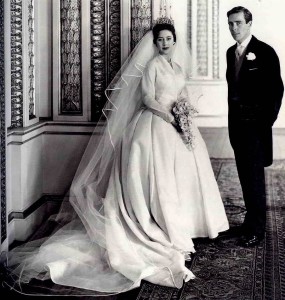
To complete her bridal ensemble, Princess Margaret wore a veil made of tulle and boarded with ivory satin which was secured in place with the beautiful Poltmore Tiara to compliment her high bun hairstyle which was chosen specifically to add height to the petite bride.
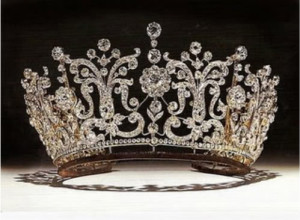
Royal Note: Princess Margaret’s wedding dress now belongs to the British Royal Collection. Also, many years later when her son, Vicount Linley married Serena Stanhope in October 1993, the bride chose a wedding dress style similar to that of Princess Margaret’s dress and she even wore her hair in the same high bun hairstyle which she wore with the Lotus Flower tiara that she had borrowed from her new mother-in-law.
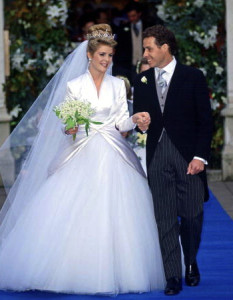
Diana Spencer, the Princess of Wales’ wedding dress
Diana Spencer married Prince Charles on July 29, 1981 in St, Paul’s Cathedral in London. One of the most closely guarded secrets of the royal wedding was Diana’s wedding dress. Much has been written about the dress which was designed by the David and Elizabeth Emanuel who were relatively unknown at the time. The famous dress that Diana wore was an ivory silk taffeta gown trimmed with antique lace decorated with 10,000 pearls and sequins, the dress also featured a 25 foot long train. Unfortunately, when she emerged from the horse-drawn Glass Coach upon arriving at the Abbey the dress looking slightly crumpled because it seems there was too small a space allowed for the voluminous amount of material. Maybe the designers should have learned from Hartnell clever use of a split in the back of the skirt of Princess Margaret’s wedding dress. (Special Note: Diana’s wedding dress is currently on display at Althorp House, the ancestral seat of the Spencer family in Suffork, and is part of a special exhibit called “Diana: A Celebration”. On occasion, the dress sometimes goes on display in a traveling exhibit, most recently it was shown in Australia, Additional Note: The Exhibit at Althorp was permanently closed in 2013)
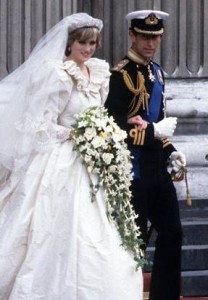
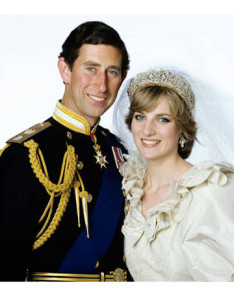
To complete her wedding attire, Diana wore the beautiful Spencer tiara, the precious family heirloom was considered her “something borrowed”. The tiara was originally given to Viscountess Althorp, Cynthia Spencer, who was Diana’s paternal grandmother as a wedding gift. In 1927, the original tiara was redesigned with additional stones taken from various other jewelry owned by the Spencer estate to create the look of the current tiara. The tiara is made in gold with diamond scrolls accented with diamond tulip and star flowers set in silver. (Special Note: The Spencer tiara occasionally goes on display during the summer months at Althorp)
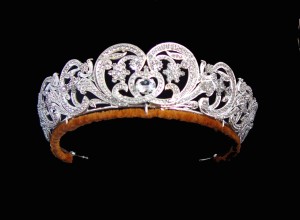
Diana’s bridal bouquet was designed by Longmans Florist; who was the same florist that made the Queen’s bouquet for her wedding in 1947. Diana’s bouquet was very large cascading style, 42” long and 15” wide. It was made of fragrant gardenias, stephanotis, freesia, Odontoglossum orchids, lilies of the valley, the Earl of Mountbatten roses, ivy and myrtle. The Mountbatten roses were used as a tribute to Prince Charles Uncle, Lord Louis Mountbatten, who died tragically in 1979. The sprig of myrtle was added to the bouquet in keeping with the royal tradition.
(If you are interested in more information about Princess Diana’s wedding dress, I would recommend “A Dress for Diana” by David and Elizabeth Emanuel”)
Sarah Ferguson, the Duchess of York’s wedding dress
The wedding of Sarah Ferguson and Prince Andrew took place on July 23, 1986 at Westminster Abbey. The designer, Linka Cierach, created a classic dress made from ivory duchesse satin which featured a deeply scooped neckline, fitted bodice, three-quarter length slightly puffed sleeves with bows at the shoulder and a full skirt. The bodice of the dress was beautifully hand embroidered with intricate beadwork and the 17 foot train featured intertwined A and S initials for the bridal couple, ship anchors to honor Prince Andrew’s naval career and bumblebees and thistles which are symbols used on the Ferguson family crest.
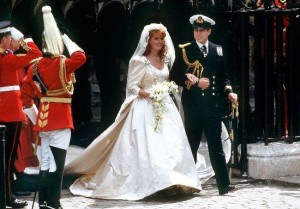
In the months leading up to the wedding day, the press and the public had increasingly commented on Sarah’s fuller figure especially when compared to the much slimmer Princess Diana and for this reason Sarah worked very hard to loose over 25 pounds. Cierach had created a dress that was perfectly tailored and accentuated Sarah’s smaller waistline.
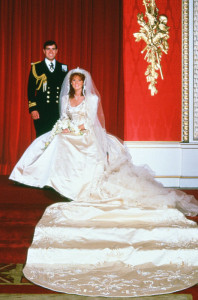
Sarah wore her red hair in long loose curls and her bridal veil was attached to her head with a floral headpiece when she arrived at the abbey. She carried a lovely S-shaped bouquet made of gardenias, cream lilies, yellow roses, lilies of the valley and the traditional sprig of myrtle. Later after the vows and signing the registry, Sarah removed the floral headpiece and exchanged it with a diamond tiara which had been purchased for her from Garrard’s by her new mother-in-law, Queen Elizabeth.
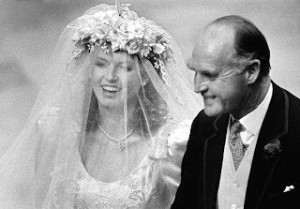
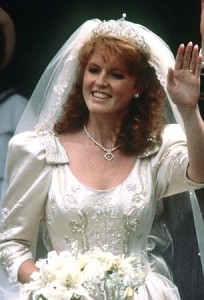
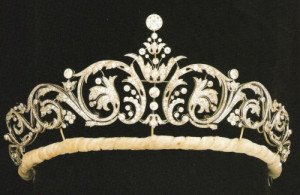
(To best honest, I preferred the Sarah the Duchess of York’s wedding dress when it is compared with the one of Diana the Princess of Wales. I really liked the more fitted bodice without excessive frills, the choice of satin instead of taffeta and the stylized embroidery and beading which added a distinctive personal touch)
Camilla Parker-Bowles, the Duchess of Cornwall’s wedding dress
Camilla Parker-Bowles married Prince Charles on April 9, 2005 at the Windsor Guildhall, later that same day in St. George’s Chapel there was a religious blessing followed by a formal reception at Windsor Castle. For the civil ceremony, Camilla wore a cream silk chiffon dress with a matching coat and she wore a Prince of Wales feather brooch attached to the coat lapel. She also wore a large Philip Treacy cream wide-brimmed straw hat covered with ivory French lace and accented with feathers. To complete her civil ceremony outfit, Camilla choose to wear L.K. Bennett shoes in an almond shade and a Launer purse made of embossed leather and lined in suede.
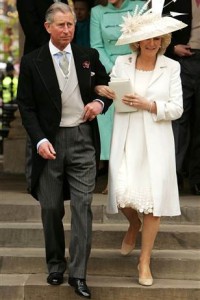
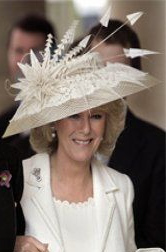
For the Church of England blessing in St. George’s Chapel, Camilla wore a Robinson Valentine long pale blue and gold embroidered damask coat over a matching chiffon gown. To complete her bridal ensemble, Camilla wore an impressive spray of golden feathers also created by Treacy in her perfectly coiffured hair instead of a tiara.
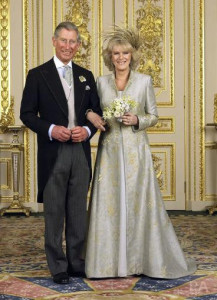
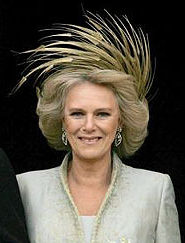
The designers struggled with creating the appropriate dresses and choosing the right accessories for both the civil ceremony and church blessing. (Personally, I think that the two dress/coat ensembles were the perfect choices and Camilla looked wonderful)
Royal Note: After the official engagement of Prince Charles and Camilla was announced there were many meetings held to discuss the unusual situation of how a previously divorced heir to the throne of England could be remarried. It had been several decades since the couple had first meet and eventually married other people only to have both those marriages end in very public and scandalous divorces and then sadly having to deal with the tragic death of Princess Diana. (Personally, I think the civil ceremony and the church blessings were the right choices for the celebrations of the marriage of Prince Charles and Camilla)
Kate Middleton, the Duchess of Cambridge’s wedding dress
Catherine (Kate) Middleton and Prince William married on April 29, 2011 at Westminster Abbey. Kate’s wedding dress, much like Diana’s was almost 30 years earlier, was a closely guarded secret. The dress was designed by Sarah Burton of Alexander McQueen. The beautiful dress was made of satin gazar with a fitted bodice, long sleeves that button at the wrist and the skirt was gathered gently at the waist over slightly padded hips that formed a bustle in the back and a 9 foot train featured lace with a floral design of roses, thistle, shamrocks and daffodil which are the National symbols of the United Kingdom. The lovely lace was appliqued by hand onto tulle and then applied to the bodice and skirt of the dress. The stunning dress was instantly compared to that of another royal bride, Princess Grace of Monaco. (For more information on the other iconic wedding dress, please click on the link The Wedding of Grace Kelly and the Prince Rainier.
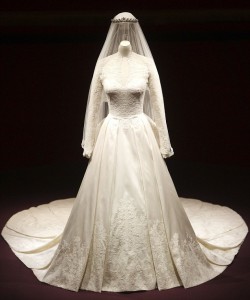
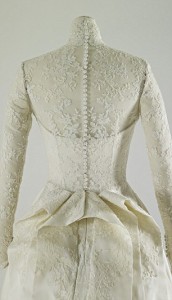
In keeping with the bridal tradition of “something old, new, borrowed and blue”, Kate’s bridal attire included the following items: vintage lace was also incorporated into the dress for “something old” as well as a blue ribbon sewn into the bodice for “something blue”. The “something new” was a set of earrings especially commissioned by Kate’s parents for her wedding day and the design came from the newly created Middleton family crest. The earrings were 18 carat white gold and diamonds in the form of curved oak leaves at the top and featured a pave diamond acorn suspended in the center of an oval-shape covered in more diamonds.
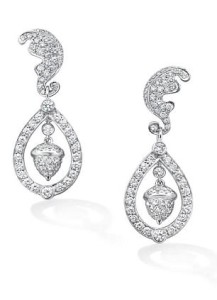
To complete her bridal attire, Kate wore a veil made of silk tulle which was embroidered with lace and held in place by the Cartier Scroll Tiara, also known as the “Halo” Tiara, which was the “something borrowed” from the Queen. The tiara was originally purchased in 1936 by the Queen’s father (later King George VI) for his wife (later Queen Elizabeth, the Queen Mother). On the occasion of her 18th birthday, the tiara was given to their daughter (Queen Elizabeth II). The Queen loaned the tiara to the bride of her grandson, Prince William. The Halo Tiara has 16 decorative scrolls set with over 800 diamonds and compliments the earrings that Kate selected to wear on her wedding day.
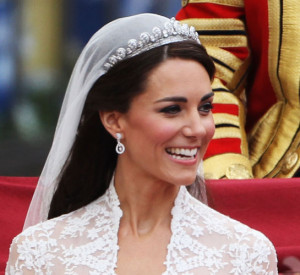
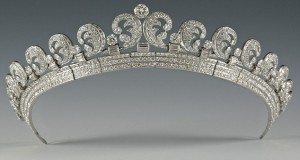
Finally, Kate carried a bouquet that traditionally “speaks” the Victorian language of flowers. The bouquet that the florist Shane Connolly created included such flowers as the lily of the valley which represented a return to happiness, Sweet William for gallantry, hyacinth for constancy of love, ivy for fidelity and friendship and lastly the tradition sprig of myrtle that is used in all royal wedding bouquet.
Like this:
Like Loading...
